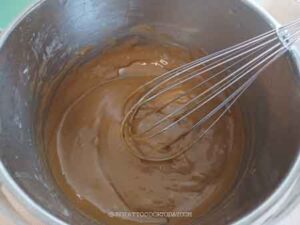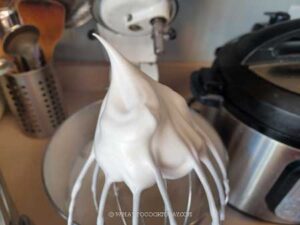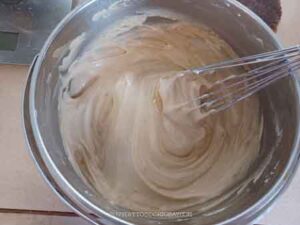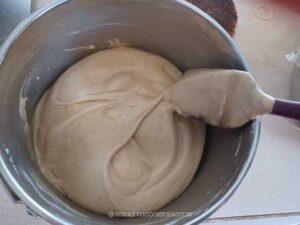This post may contain affiliate links. Please read our disclosure policy.
Light, airy, and full of smooth Malaysian white coffee flavor, this White Coffee Chiffon Cake is the perfect treat for coffee lovers. Learn tips, tricks, and storage secrets for the perfect chiffon every time.
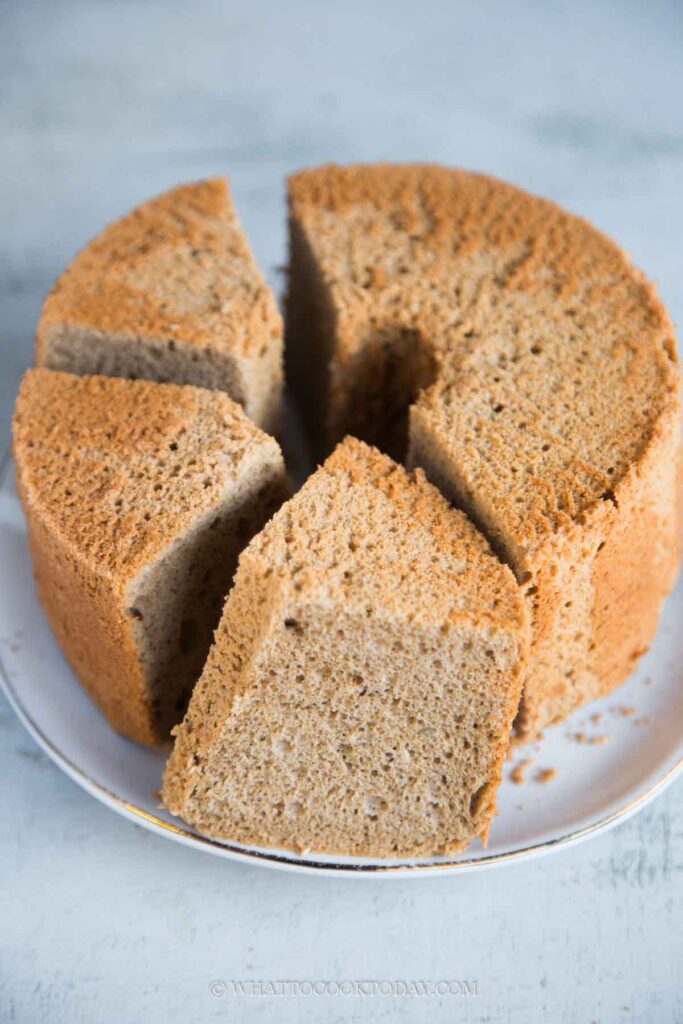
If you’ve been around here for a while, you know I LOVE chiffon cakes. They’re light, bouncy, and just so fun to eat. This white coffee chiffon cake is one of those recipes I’ve been super excited to share because it’s a little different from the usual coffee chiffon. And yes—the “white” in white coffee is confusing because the coffee is definitely not white.
I’ve heard about white coffee for years, especially how popular it is in Malaysia, so when my husband traveled there recently, I told him: “Please bring me a big pack of white coffee!” I’ve always been a black coffee person, but I was really intrigued by this Malaysian-style white coffee and wanted to use it specifically in baking. And let me tell you…it’s SO good in chiffon cake. The aroma, the flavor—it gives the cake that unmistakable Southeast Asian coffee shop vibe.
What Is Malaysian White Coffee? (And Why It Isn’t Actually White)
Despite the name, white coffee isn’t made from white beans or roasted lightly. In Malaysia, “white coffee” refers to coffee beans roasted in margarine (traditionally palm-based), without the addition of sugar, giving the coffee a lighter roast profile and a very smooth, aromatic flavor.
This Malaysian white coffee has a very distinct flavor that carries beautifully in baked goods—especially chiffon cakes, because the airy crumb lets the fragrance come through. So, if you also have a pack of 3-in-1 white coffee mix sitting around, here’s the perfect way to use it.
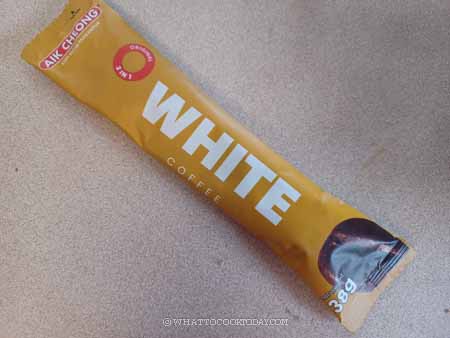
Why You’ll Like This Recipe
- The flavor is amazing — white coffee gives a uniquely smooth, caramel-coffee aroma that’s different from regular coffee chiffon.
- Super soft and airy — the combination of cake flour + stable meringue makes the cake cloud-soft.
- Great rise — the method ensures tall, even height without collapse.
- Uses pantry-friendly 3-in-1 white coffee mix — no fancy extraction needed.
- Perfect for coffee lovers who want something lighter and not too sweet.
Ingredients & Substitutions (No Measurements)
- White coffee mix
Use any Malaysian-style 3-in-1 white coffee. Regular instant coffee works too but the flavor will be different. - Hot water
Needed to dissolve the coffee mix. - Neutral oil
Any neutral oil like canola, vegetable, or grapeseed. - Egg yolks & egg whites
I recommend using a kitchen scale to weigh because eggs come in different sizes. I use large-size eggs. Separate when cold for easier handling. - Cake flour
Provides the chiffon’s delicate structure. - Sugar
Regular granulated sugar. Do not reduce too much or the meringue may be unstable. - Vinegar or lemon juice
Acid helps stabilize the meringue. You can also use cream of tartar.
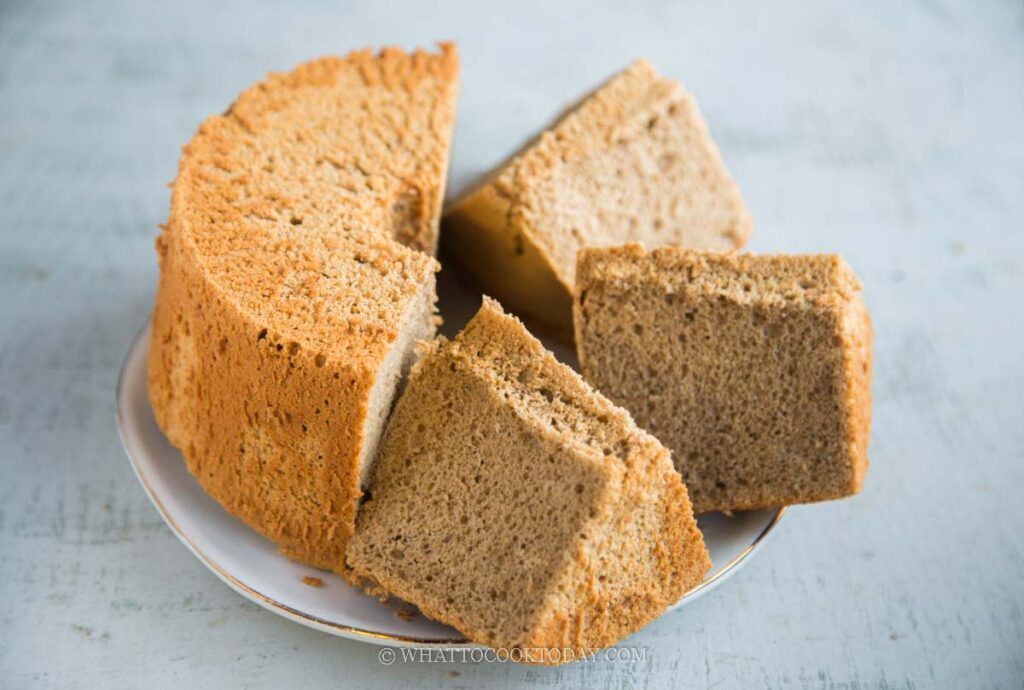
How to Store Chiffon Cake
- At room temperature (best option):
Keep the cake in an airtight container for up to 3 days. Chiffon stays soft and moist at room temp. Avoid refrigerating unless absolutely necessary. - In the refrigerator (if your kitchen is very warm):
Wrap the cake in plastic wrap to prevent dryness, then place it in an airtight container. Refrigerate for up to 5 days. Bring to room temperature before eating for the fluffiest texture. - Freezing (great for longer storage):
Wrap the whole cake or individual slices in plastic wrap, then place them in a freezer-safe bag or container. Freeze for up to 1 month for best flavor. Thaw at room temperature (while still wrapped) for about an hour. - Make-ahead tip:
Chiffon cake tastes even better the next day, so feel free to bake it 24 hours ahead of serving. Just store it properly so it stays soft and bouncy.
Frequently Asked Questions
- Can I use regular instant coffee instead of white coffee?
Yes! The cake will still taste great, but the flavor won’t have that smooth, creamy, slightly caramelized aroma that Malaysian white coffee is known for. Regular instant coffee tends to taste sharper and more bitter. - Can I use freshly brewed coffee?
You can, but it’s not ideal. Brewed coffee is more diluted and won’t give you the same strong aroma. Instant white coffee mix gives the most consistent and intense flavor. - Why did my chiffon cake collapse?
The most common reasons are underbaking, overfolding the batter, under- or over-whipped meringue, or using a greased/nonstick pan. Chiffon needs an ungreased surface to cling to or it will deflate. - Is it normal for chiffon cake to crack on top?
Totally normal! That cracked top becomes the bottom once the cake is unmolded. A crack usually means your chiffon rose well. - Why is my chiffon cake dense or rubbery?
This happens when the flour isn’t fully incorporated, the batter is overmixed, or the meringue is unstable. Low oven temperature can also make the cake dense. The batter should stay fluffy and airy going into the oven. - Can I bake chiffon in a regular round cake pan?
No, the cake will not rise well and most likely will collapse when you cool it down. A tube pan still gives the most reliable rise. - Can I reduce the sugar?
I don’t recommend. This cake is not very sweet. At least follow the recipe exactly for the first time and see how it’s like before you start adjusting - Why does chiffon taste better the next day?
The flavor intensifies and deepens overnight, especially when paired with coffee. The crumb also becomes softer as moisture distributes evenly throughout the cake.
This Malaysian white coffee chiffon cake is one of those recipes that feels special but is actually super simple once you get the hang of the chiffon method. I really love how Malaysian white coffee produces a smooth, nutty, milky aroma that’s so distinct from using regular instant coffee. If you’ve never baked with white coffee before, this is definitely the place to start.
If you’re feeling extra indulgent, serve with a lightly sweetened whipped cream or a drizzle of white coffee glaze—trust me, it’s heavenly.
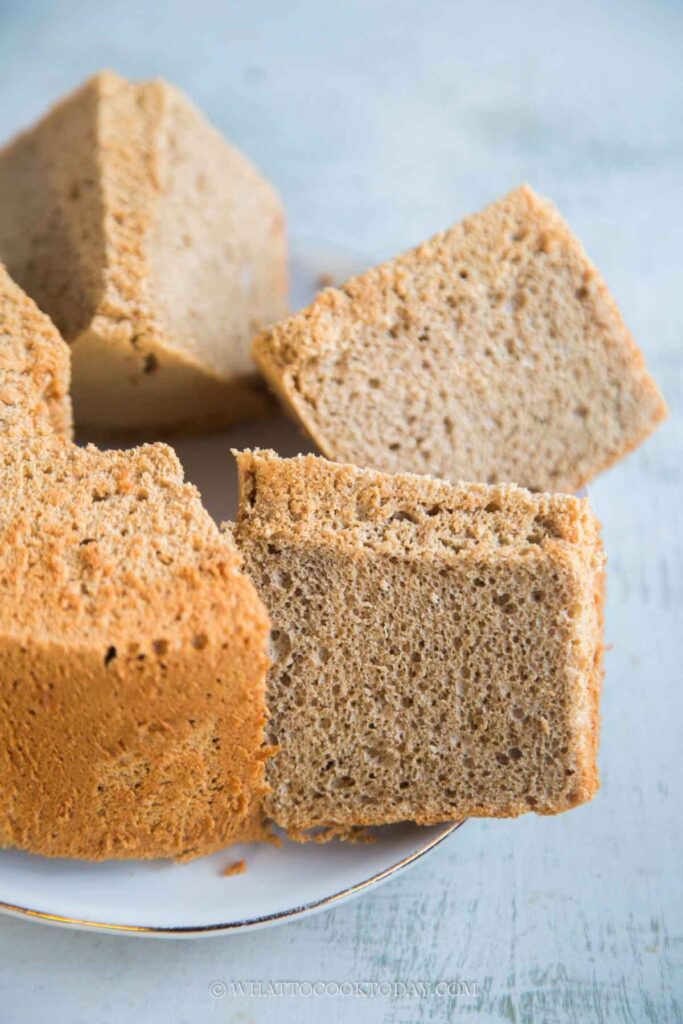
Malaysian White Coffee Chiffon Cake
Ingredients
For 6-inch (15 cm) tube pan:
For cake batter:
- 38 g 3-in-1 white coffee mix
- 60 g hot boiling water
- 42 g oil
- 90 g cake flour
- 60 g egg yolks from 3 large-size eggs
For meringue:
- 110 g egg whites from 3 large-size eggs
- ½ tsp vinegar or 1/2 tsp cream of tartar
- 42 g sugar
For 8-inch (20 cm) tube pan:
For cake batter:
- 76 g 3-in-1 white coffee mix
- 100 g hot boiling water
- 70 g oil
- 90 g egg yolks from 5 large-size eggs
- 150 g cake flour
For meringue:
- 150 g egg whites from 5 large-size eggs
- 1 tsp vinegar or use 1 tsp cream of tartar
- 70 g sugar
Instructions
- Make sure your chiffon cake pan does not have a non-stick coating or your cake will not rise. The cake needs to cling to the side of the pan to rise tall
- Get the eggs out of the fridge and separate them when they are still cold. They are easier to separate when they are cold. Let the yolks and the whites come to a room temperature, this may take about 30 minutes or so
Prepare the cake batter:
- Preheat your oven to 330 F (165 C) for conventional oven. If you have a convection oven, I suggest lowering the temperature by 25 F (15 C). Place the oven rack 4th from the top (or adjust accordingly, you will know your oven best)
- Combine the white coffee mix with hot water and set aside to let it cool down to at least lukewarm.

- Place the egg whites in a clean mixing bowl. I use a stand mixer with a whisk attachment. You will have trouble whipping your meringue if there's a trace of grease in your utensils or bowls
- In a separate bowl, whisk the egg yolks, sugar and cooking oil, then add milk and coffee mixture. Sift in the cake flour and salt into the batter. Whisk to mix into a smooth batter. Set aside

Whipping the meringue:
- Beat the egg whites on medium speed until frothy, add cream of tartar or lemon juice/vinegar and whip until it turns whitish and air bubbles are fine. Gradually add the sugar as you beat, in 3 batches. I beat them at medium speed (speed 6 on Kitchen Aid). This will take a bit longer compared to beating at high speed. I used to do higher speed (speed 8), but the meringue is smoother and nicer when I maintain the speed on 6 and much more stable too. I highly recommend stopping several times to check on the consistency and scraping the sides of the bowl to make sure no sugar left on the side of the bowl. Whip until you reach a stiff peak but still have a slight bent on the tip. Then lower the speed to 4 and whip for 1 minute to even out large bubbles and stop beating

Fold meringue into the cake batter:
- Gently fold 1/3 of the meringue into the thick batter. Using a whisk, using a cutting motion and fold over to mix.

- Repeat this motion several rounds. Continue on with the second 1/3 of the meringue again to mix.

- For the last 1/3 of the meringue, use a rubber spatula instead to ensure you get all the batter at the bottom of the bowl mixed in as well. Use a cut down in the middle and fold over motion to fold gently but quickly.

- Make sure you don't see any more white meringue. The mixture should be fluffy and voluminous.

- Pour the batter into an UNGREASED chiffon cake pan. Use a rubber spatula to smooth the surface. Gently drop the cake pan from about 10 cm height on the counter 2-3 times. Use a skewer to draw a zig zag to pop bubbles inside the cake batter

Baking:
- Put the chiffon pan in the middle rack and let it bake for 40-45 minutes for 6-inch chiffon cake, and 50-55 minutes for 8-inch chiffon cakeThe time is just for a reference. Your oven may need less or more time to bake
Test for doneness:
- I know this is weird to say, but it's actually "safer" to overbake chiffon cake than underbaking. Underbaking tends to cause the cake to collapse. Usually if you insert a skewer inside the cake and no crumbs stick to it or very minimal crumbs, it is safe to say that the cake is cooked through. You can also touch the top and if it springs back, it's a good sign that it's cooked through. I like to have some golden brown on top. I don't know if you notice, but when the cake has a golden brown color on top, it's actually more flavorful too than when the cake is pale in color
- Don't be alarmed if your cake has some cracks on top. What you are looking at will become the bottom of your cake. I know many people mind it a lot and make a big fuss when the top of the chiffon cake cracks, but actually it's not a flaw.
Cooling:
- Drop the cake pan from about 10 cm height on the counter several times to prevent shrinkage when you pull the cake out of the oven. Then carefully invert the pan upside down immediately. Please don't be tempted to remove it from the pan if it's still warm. It takes about one to two hours to cool down completely

- Once it's cool down completely, use a spatula knife to run through the edge and the outer center of the tube to help release the cake. Gently push the base to lift the cake out. Use the knife again to run through the base of the pan and then carefully release the cake.
- I suggest that you wait for 24 hours before serving the cake (if you can wait). The flavor always gets better the next day compared to when you serve it on the same day
How to store:
- Let the cake cool down completely. Store the cake in an air-tight container for up to 3 days at room temperature. Try to finish it within 3 days (which I'm sure it will be gone before then)

